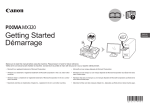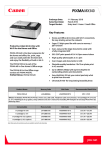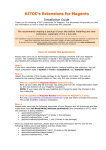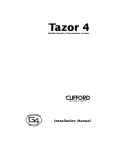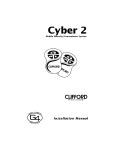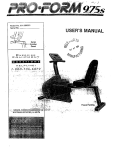Download P-Space user manual - Universitat de Barcelona
Transcript
P-Space
Version 3.3
User manual
February 2000
Grup de Tecnologia Informàtica en Ciències del Comportament
Computer Technology in the Behavioral Science Research Group
University of Barcelona, Spain
P-Space 3.3
User manual
1
Contents
Introduction ......................................................................................................... 2
Installation........................................................................................................... 4
Running .............................................................................................................. 5
Hot keys.............................................................................................................. 7
Commands ......................................................................................................... 8
Examples .......................................................................................................... 29
Output............................................................................................................... 31
Errors................................................................................................................ 33
P-Space 3.3
User manual
2
Introduction
P-Space is a program that stimulates spatial behavior in a group of agents (humans, robots,
etc). Agents have attitudes towards each other, which determine the constant or variable ideal
distances they want to keep from other agents. Agents live in a universe called room, which
they can exit and re-enter (if doors exist). The room can contain objects, or areas unavailable to
agents. The room is divided into cells, and time is measured discretely. A cell cannot be
occupied simultaneously by more than one agent. At each time unit, each agent is at the center
of its own neighborhood of cells, an area surrounding the agent and limiting the cells where it
will be able to move to at the next time unit. When agents move, their neighborhoods move with
them.
An agent moves to that cell in its current neighborhood that will minimize its social
dissatisfaction. An agent's dissatisfaction is defined as a weighted function of the discrepancy
between possible future distances, as estimated by the agent, and ideal distances from each
other agent. The ideal dissatisfaction (the one the agent wishes to get) is its minimum possible
dissatisfaction before moving, and the real dissatisfaction is the one it has after moving. These
dissatisfactions can differ because the other agents might have moved to other cells in their
respective neighborhoods, and thus the agent will not reach its ideal dissatisfaction.
The
difference between real and ideal dissatisfaction is the agent's frustration.
At each time unit agents decide to move within their respective neighborhoods simultaneously
and independently. However, if two or more neighborhoods overlap, then some of their cells
may be candidates for more than one agent if they happen to provide minimum dissatisfactions
for all of them. At each time unit, agents' priorities to move are sorted randomly. Then, agents
with lower priorities will be able to move only to those cells not chosen by agents with higher
priorities.
Agents have individual features which determine their attention scopes, their tendencies to exit
the room, their tendencies to remain outside, and the effect that real distances from other
agents have on the discrepancies between real and ideal distances (agent gravity).
Ideal distances can be neutral, constant, increasing or decreasing as a function of time,
random, a function of time in proximity between the agents, or, generally, a function of their
interactions (ideal distance models). Ideal distances from agents to objects and from agents to
doors can be defined as well. Different models can be defined for each agent-to-agent, agentto-object, and agent-to-door interaction.
As agents move to those cells in their neighborhoods where dissatisfactions tend to minimize
(that is to say, where real and ideal distances are most similar), they will keep moving around
the room until their dissatisfactions are null. Nevertheless, it may be that, due to the ideal
P-Space 3.3
User manual
3
distances of other agents, the null level of dissatisfaction is unreachable. In this case the group
as a system can reach either static or dynamical stability (agents stop moving or keep moving
indefinitely). Likewise, if agents get in and out of the room, or if ideal distance models that are
functions of time in proximity have been defined, then steady states or a dynamic equilibria can
be reached, and be broken periodically or chaotically.
P-Space 3.3
User manual
4
Installation
After downloading P-Space, copy file PSPACExx.ZIP (where xx indicates the program version)
to a directory in your system and unpack it using Pkunzip or WinZip. Program P-Space consists
of the following files:
PSPACE.EXE
Executable
PSPENGxx.TRB
English message file
PSPESPxx.TRB
Spanish message file
PSPCATxx.TRB
Catalan message file
PSPENGxx.HLP
English help file
PSPESPxx.HLP
Spanish help file
PSPCATxx.HLP
Catalan help file
PSPESPxx.NAV
English help navigation file
PSPESPxx.NAV
Spanish help navigation file
PSPCATxx.NAV
Catalan help navigation file
V.EXE
File browser
VENG.TRB
File browser English message file
VESP.TRB
File browser Spanish message file
VCAT.TRB
File browser Catalan message file
EGAVGA.BGI
Borland DOS graphical interface file
LITT.CHR
Borland graphical font file
All the files must be in the same directory.
P-Space 3.3
User manual
5
Running
P-Space 3.3 runs in DOS or in a Windows 98 window. In order to run P-Space, you must first
write down commands specifying the number of agents, their features, the room size, the ideal
distance models, and so forth, and save them as an ASCII file. Commands must follow a
specific P-Space syntax or set of conventions (described below):
To run the program, change to the P-Space directory and type one of the following commands:
PSPACE
The program prompts for a command file name, and simulates
according to the commands specified in the file. Default system
language is used (English, Spanish, or Catalan).
PSPACE –i
Ditto in English
PSPACE -e
Ditto in Spanish
PSPACE –c
Ditto in Catalan
PSPACE <file>
Simulates according to the commands specified in the file.
Default system language is used (English, Spanish, or Catalan).
PSPACE <file> -i
Simulates according to the commands specified in the file.
Commands must be written in English.
PSPACE <file> -e
Simulates according to the commands specified in the file.
Commands must be written in Spanish.
PSPACE <file> -c
Simulates according to the commands specified in the file.
Commands must be written in Catalan.
PSPACE -?
Displays help text, using default system language. If file browser
V.EXE is in the same directory, then P-Space will call it in order to
display the help, otherwise help will be simple printed to the screen.
After displaying help, the program will prompt for a command file (if you
do not want to run any simulation, press Ctrl-C at the prompt).
PSPACE -? -i
Ditto in English
PSPACE -? -e
Ditto in Spanish
PSPACE -? –c
Ditto in Catalan
Default language used by the program is the OS language. However, if P-Space fails to detect
the OS language, then either it must be forced to run using the desired language (with running
options –i, -e, -c), or commands must be written in the language that P-Space recognizes
as default.
P-Space 3.3
User manual
6
The help displayed by the program on screen are the contents of the HLP files. They are ASCII
files, and can be read or printed by any text editor or word processor. Their contents are a
summary of this user manual. When in the file browser V.EXE, press F3 to navigate the help
text.
P-Space 3.3
User manual
7
Hot keys
While the program is running in graphical mode (see OUTPUT), the folowing hot keys can be
used:
•
R (Run): Starts the simulation, or resumes it if it was stopped.
•
S (Step): Stops the simulation, and executes one step or time unit. Pressing R again
resumes the Run mode.
•
+: Increases execution speed (i.e., reduces the pause between consecutive steps; see
PAUSE).
•
-: Decreases execution speed (i.e., increases the pause between consecutive steps;
see PAUSE).
•
C (Chaos): Inserts chaos in the movements of the agents, provoking that they move
randomly within their neighborhoods at the current time unit (see CHAOS).
•
E (End): Ends the simulation. Pressing E twice terminates the program. If more than
one simulation was requested in the command file (see NSIMULATIONS), then
pressing R after E starts the next simulation.
P-Space 3.3
User manual
8
Commands
In order to carry out a simulation, P-Space must read commands from an ASCII command file,
which can be created using any text editor.
•
Only the IDEAL command is mandatory, the rest are optional. If they are omitted, default
parameters for them are used. Except for specific cases, commands may be entered in any
sequence.
•
Commands must fit in a single line of text. Only the IDEAL command may expand more
than one line.
•
Only the first four letters of command names and alphanumerical parameters are
necessary.
•
Command and parameters names are case insensitive.
•
Comments can be inserted in the command file by adding a % sign in the first column,
which indicates that the rest of the line must be ignored. Therefore, in order to cancel out a
command without deleting it, just precede the command with a % sign.
•
In the specifications that follow, { } enclose items that are optional and can be specified
progressively, that is { a b c d } means that a, b, c, and d may be omitted; or that a may be
specified, and b, c, and d omitted; or that a and b can be specified, and c and d omitted; or
that a, b, and c may be specified, and d omitted; or that a, b, c, and d may be specified.
Square brackets [ ] enclose items that are mandatory. A vertical bar separates mutually
exclusive items.
NSIMULATIONS n
Specifies that the process must be repeated n times. Note that if you request that results be
saved to a file, a large n usually generates a huge file (see OUTPUT). Default is n = 1.
TIME t
Specifies the total number of steps or discrete time units for the simulation. Total number of
steps will equal t by the number of simulations. Note that if you request that results be saved to
a file, its number of lines will equal the total number of steps at least (see OUTPUT). Default is t
= 100.
ROOM x y
Defines the size of the room where agents will move. The room is a rectangle with horizontal
side x and vertical side y, where x and y are expressed in number of cells. A cell is represented
on the screen by a square of 5 by 5 pixels. “Horizontal” (or width) and “vertical” (or depth) refer
to the room location on screen. Walls are called north, east, south and west. Maximum room
size is x = 120, y = 90, and minimum is x = y = 10. If x ≤ 80, and graphical output is requested
P-Space 3.3
User manual
9
(see OUTPUT), then two additional graphical representations are shown: density of occupation,
and a plot of variables chosen by user (see SQUARE). If y ≤ 70, then an additional plot
specified with the RECTANGLE command is displayed below the room. Default is x = 30, y =
30. Figure 1 shows a P-Space sample screen.
Figure 1. Sample screen of a P-Space simulation. A room with three interacting agents, one
object, and two doors is shown in the upper left area. The upper right section of the screen
displays the room to scale, where frequency of occupation is represented using color codes in a
real screen. The lower left plot shows the agents' real dissatisfactions as a function of time.
Ideal and real distances between agents as a function of time are shown in the lower right 3x3
grid. Actual graphical representations may vary depending on the room size specified, and on
the variables selected for the lower right (see SQUARE) and lower left (see RECTANGLE)
areas.
P-Space 3.3
User manual 10
NAGENTS n
Defines the number of agents. Maximum is 20 and minimum is 1. The greater the number of
agents, the slower the simulation. Default is n = 10. If agent features are specified by means of
AGENT or BLOCK commands, then NAGENTS may be omitted. If NAGENTS is specified, then
it must precede any AGENT or BLOCK command. NAGENTS is useful for specifying a number
of agents different from the default one, while accepting default parameters for the agents'
features. If NAGENTS is specified but not AGENT or BLOCK, then initial agent coordinates will
be randomly selected. When an output file is requested (see OUTPUT), its size increases
exponentially as the number of agent increases.
AGENT x y { heading angle limit timeout
IN | OUT SAME | RANDOM EXIT | NOEXIT }
Defines an agent's individual features:
•
x, y are its initial coordinates within the room, measured in number of cells to the right and
downwards from the origin of coordinates (0,0), the cell in the upper left corner of the room
(see Figure 2). If x = -1, y = -1, or both, then initial coordinates will be randomly selected. If
x = -2, y = -2, then the agent will be initially out of the room, which is equivalent to specifying
the OUT parameter.
•
heading is the agent's initial heading, measured in degrees from 0 to 360 counterclockwise
from axis X. For an agent facing the east, north, west, and south walls, heading equals 0,
90, 180 and 270 degrees respectively. Once the simulation has started, a vector joining its
positions at times t-1 and t defines the agent's heading. By default, initial heading is
selected randomly.
•
angle is the agent's attention scope angle, measured in degrees and centered at the vector
defining its current heading. Default is 360 degrees.
•
limit is the maximum distance to which the agent pays attention. Default is 1000. Angle and
limit define a circular sector that is the agent’s attention scope. The agent ignores the area
within the room that is outside its current attention scope. Therefore, the agent acts as if its
ideal distance to agents, objects, and doors lying in that area is neutral (in Figure 2, the
white area represents the agent's current attention scope).
•
timeout is the mathematical expectancy of the amount of time that the agent will remain out
of the room after exiting it, or before entering it for the first time if it was initially out. Actual
time out is computed by sampling from an exponential distribution whose mathematical
expectancy equals timeout. Default is 0.
•
IN or OUT specify the agent's place when the simulation starts. If OUT is specified, then the
initial coordinates are dummy. If OUT is specified and the room has no doors (see DOOR),
then the agent will remain out of the room throughout the simulation. Default is IN.
P-Space 3.3
•
User manual 11
SAME or RANDOM define the door used by the agent for reentering the room: either the
same door through which it exited the room previously or a door selected at random. If
there are no doors, then this parameter is dummy. Default is SAME.
•
EXIT or NOEXIT define the agent's readiness to exit the room when it happens to step on a
door threshold. An agent stepping on a door threshold will exit the room if its current ideal
distance to the door is 0, even if its tendency is NOEXIT; it will not exit the room if its
tendency is NOEXIT and its ideal distance to the door is not zero at that moment. If there
are no doors, then this parameter is dummy. Default is NOEXIT.
Parameters in the AGENT command can be specified progressively. Initial coordinates are
mandatory, but the other parameters may be omitted. For example, we could specify initial
coordinates, initial heading, and attention scope angle only:
AGENT 30 40 0 180
In this case, missing parameters will be assigned their default values.
If the NAGENT command is used, then the number of times that AGENT command is specified
subsequently cannot be greater than the number of agents. If the AGENT command is specified
a number of times less than the number of agents, then unspecified agents will be assigned
their default parameter values. When graphical output is requested (see OUTPUT), icons of 5
by 5 pixels are used for representing agents on the screen. Different types of icons are available
(see ICON).
Figure 2. Coordinates, heading, and attention scope of an agent moving around the room.
P-Space 3.3
User manual 12
BLOCK n { heading angle limit timeout
IN | OUT
SAME | RANDOM
EXIT | NOEXIT }
Defines identical features for a block of n agents. Initial coordinates will of course be different
for the agents in the block. If they are initially IN the room, then their coordinates will be
assigned randomly. Parameter default values are the same as the ones for the AGENT
command. Total number of agents, specified in one or more blocks, plus total number of times
that AGENT is specified cannot exceed the number of agents defined with NAGENT or the
maximum number of agents that is permitted.
NOBJECTS n
Specifies the number of objects in the room. They are all rectangular. When graphical output is
requested (see OUTPUT), each object is represented by a different color. Maximum number of
objects is 5 and minimum is 0. Default is 0. To define objects, simply use as many OBJECT
commands as necessary, and omit NOBJECTS. Nevertheless, if NOBJECTS is used, then it
must precede any OBJECT command.
Figure 3. Object coordinates and door position.
P-Space 3.3
User manual 13
OBJECT x1 y1 x2 y2
An object is defined by specifying coordinates for its northwest (x1,y1) and southeast (x2,y2)
corners (see Figure 3). Objects are areas forbidden to agents, but agents can detect each
other even if interposed objects exist between them. Overlapped objects are not permitted.
Objects with corners outside of the room are trimmed off by the program. Real distance
between an agent and a object is defined as the minimum of the distances from the agent to the
four corners of the object, provided that corners fall within the agent´s attention scope. Real
distance between two agents when objects are interposed between them is calculated as the
shortest of all possible paths surrounding the objects and connecting the two agents. If
NOBJECTS was specified previously, then the OBJECT command must be used as many times
as necessary.
NDOORS n
Specifies the number of doors in the room. When graphical output is (see OUTPUT), doors are
represented on the room walls using red lines. Maximum number of doors is 6 and minimum is
0. Default is 0. To define doors, simply use as many DOOR commands as necessary, and omit
NDOORS. Nevertheless, if NDOORS is used, then it must precede any DOOR command.
DOOR { NORTH | SOUTH | EAST | WEST } position
A door is defined by specifying a wall (NORTH, SOUTH, EAST, WEST) and a position or
coordinate for its center. All doors are 10 cells wide (see Figure 3). For example, DOOR
NORTH 20 is a door in the north wall, centered at 20 cells from the west wall. DOOR WEST 20
is a door in the west wall, centered at 20 cells from the north wall. Real distance between an
agent and a door is defined as the distance from the agent to the center of the door, provided
that it falls within the agent´s attention scope. If NDOORS was specified previously, then the
DOOR command must be used as many times as necessary.
GRAVITY g [ agent | ALL ]
Defines gravity g for an agent or for all of them. Agents are identified by their numbers (1, 2, ...).
A single gravity may be defined for all agents by specifying ALL.
As many GRAVITY
commands may be used as agents have been previously defined. Agent numbers used in this
command must refer to existing agents. Minimum gravity is 0.0 and maximum is 1.0. Default is
1.0. The greater the gravity, the higher the weighting of the differences between real and ideal
distances on dissatisfactions. The smaller the gravity, the lower the weighting. When gravity is
high, the effect of those differences on dissatisfaction depends very little on the real distances.
When gravity is low, real distances must be small for the differences between real and ideal
distances to affect dissatisfaction.
P-Space 3.3
User manual 14
CHAOS p
Specifies the probability p that the agents choose random positions within their neighborhoods at
each time unit, instead of those positions that minimize their dissatisfactions. If p = 0, then
positions are never chosen randomly. Default is 0. When the program is running, chaos can be
inserted simultaneously in all the agents by typing the hot key C. A magenta vertical line is
displayed on the rectangular plot (see RECTANGLE) indicating the time unit when the key was
pressed.
INERTIA p
Specifies the degree of inertia or constancy p (0 ≤ p ≤ 1) in the direction of movement when an
agent is neutral towards evey other agent (see IDEAL). If inertia equals 1, then the agent will tend
to move following its initial heading (if it hits a wall, its heading changes). If inertia equals 0, then
the agent chooses a random heading at each time unit. Inertia works when agents are non-neutral
as well, although in that case it may be masked by movements caused by changes in ideal
distances. Inertia affects the agent decision as to which cell in the neighborhood is chosen when
several cells have identical and minimum ideal dissatisfaction: If inertia is 1, then that cell having
the minimum difference in heading relative to the current position will be chosen. If inertia is less
than 1, then a probability (equal to 1 − p ) exists that a cell is randomly chosen among those
sharing the minimum dissatisfaction.
NEIGHBORHOOD [ CIRCULAR | MOORE | NEUMANN | MVONN ] [ 3 | 5 | 7 | 9 | 11 | 13 | 15 ]
Defines the agents' neighborhood, a region of cells surrounding each agent at time t and limiting
the area where it can move at time t + 1. At time t + 1, the new neighborhood surrounds the
agent's new position. Neighborhoods are usually symmetrical around the agent's position. Size
and shape of neighborhood are the same for all agents. Neighborhoods of different agents can
overlap. Default neighborhood is CIRCULAR 3. Long neighborhood diameters cause faster
agent movements, and prevent that agents block each other at room corners. In MOORE and
MVONN neighborhoods, movements can be in vertical, horizontal and diagonal movements; in a
NEUMANN one, they can only be in vertical and horizontal directions; in a CIRCULAR one,
movements are isotropic (see Figure 4).
Figure 4. Some examples of neighborhoods. Black cells indicate the agent's current position.
P-Space 3.3
User manual 15
GEOMETRY [ EUCLIDEAN | CITYBLOCK | MAXIMUM ]
Specifies the geometry for the two-dimensional space where agents move. In an EUCLIDEAN
geometry, distance between two points i y j with coordinates (xi, yi), (xj, yj) (for example, two
agents) is defined as:
d ij = ( xi − x j ) 2 + ( yi − y j ) 2
In a CITYBLOCK geometry, it is defined as:
d ij = xi − x j + yi − y j
And in a MAXIMUM geometry, it is defined as:
(
d ij = max xi − x j , yi − y j
)
If agents were points with no dimension and the space they move around were really
continuous, then the appropriate geometry would be EUCLIDEAN. In that case, an agent
neighborhood would be a circle. However, as agents are located on and move around discrete
cells, their actual neighborhoods and the space geometry are approximations. When
neighborhood is CIRCULAR and its diameter is large, the euclidean distance between two
agents approaches the shortest path between them. When neighborhood is NEUMANN, the
city-block distance between two agents equals the shortest path between them. When
neighborhood is MOORE or MVONN, the maximum distance between two agents approches
the shortest path between them. Default geometry is EUCLIDEAN. The maximum possible
distance in the room (maxdist) equals the length of the room's diagonal when geometry is
EUCLIDEAN, the sum of its sides when geometry is CITYBLOCK, and its longer side when
geometry is MAXIMUM.
ICON [ FACE | CROSS | CIRCLE | HEADING | READINESS ]
Defines the icon used to represent agents when graphical output is requested (see OUTPUT).
Default value is FACE. When FACE, CROSS, or CIRCLE are specified, a single type of icon is
used for representing the agents, both when they are inside and outside of the room, and also
for identifying them in other graphs (see SQUARE and RECTANGLE). When ORIENTATION is
specified, agents in the room are represented by arrows showing their approximate headings
(with a precision of 45 degrees), while agents outside of the room are represented by arrows
pointing east. When TENDENCY is specified, solid and empty circles are used for representing
agents with EXIT and NOEXIT readinesses, respectively. Icons shown in the SQUARE and
RECTANGLE plots are surrounded by arcs showing the areas falling out of the agent’s attention
scope angle. When an agent is out of the room, its icon is shown left to the west wall, and the
P-Space 3.3
User manual 16
time left until the agent will reenter the room is represented by an arc surrounding the icon. This
command is dummy when no graphical output is requested (see OUTPUT).
Icon colors are repeated for agents 1 and 11 (green), 2 and 12 (red), and so forth. Two slightly
different icon subtypes are used for distinguishin agents 1 thru 10 from agents 11 thru 20:
Icon type
Agents 1 thru 10
Agents 11 thru 20
ICON FACE
ICON CROSS
ICON CIRCLE
ICON HEADING
ICON READINESS
If EXIT
If NOEXIT
SQUARE [ DISTANCE { agent1 agent2 … } |
PHASE { DISTANCE | DISSATISFACTION | FRUSTRATION | ENCODED
lag LINK | NOLINK } ]
Specifies the graph to be shown on the lower right square area of the screen. DISTANCE
indicates that a matrix of ideal and real distances must be plotted against time for every agentto-agent interaction. By default, real and ideal interagent distances are plotted against time for
agents 1 thru n, with n ≤ 10. Specific agents can be selected by number.
PHASE indicates that a certain variable at time t must be plotted against its value at time t - lag.
Phase plots for the mean real distance among agents, their mean real dissatisfaction, their
mean frustration, or their encoded frustration can be requested. An agent’s frustration at time t
is defined as the difference between its real and ideal dissatisfactions at t. Encoded frustration
n
is an integer between 0 and 2 -1, where n is the number of agents. At time t, the encoded
frustration is computed as:
f ( n − 1) ⋅ 2
n −1
+ f ( n − 2) ⋅ 2
n−2
1
0
+ K + f (1) ⋅ 2 + f (0) ⋅ 2
where f ( k − 1) = 1 if agent k’s frustration is positive at t,
f ( k − 1) = 0 if agent k’s frustration is negative or zero at t.
Lag is an integer between 1 and 20; default is 1. When LINK is requested, consecutive data
points are linked by a straight line. Default is NOLINK. This command is dummy if no graphical
output is requested (see OUTPUT), or if room width is greater than 80 (as it prevents the square
graph to be displayed).
P-Space 3.3
User manual 17
RECTANGLE [ [ DISSATISFACTION | DISTANCE | FRUSTRATION ] { agent1 agent2 … }
| AGGREGATION { maxneighbor } ]
Specifies the graph to be shown on the lower left rectangular area of the screen. Agent’s real
dissatisfaction, its mean real distance from other agents, its frustration, or aggregation indexes
can be plotted against time. By default, dissatisfactions are plotted. When DISSATISFACTION,
DISTANCE, or FRUSTRATION are requested, specific agents can be selected by number. If
agent numbers are omitted, then dissatisfactions, distances or frustrations are plotted for every
agent. If the first agent number is zero, then the mean value (±2 standard deviations) of the
requested variable for all agents is plotted against time. At time t, only variables for agents in
the room at that moment are plotted.
If AGGREGATION is requested, then Clark-Evans’ nearest neighbor index is plotted against
time, with its 95% non-significant bounds. This index is distributed as a normal standard score.
When the agents are distributed randomly in space, the index is non significant. When the
agents are clustered, it is negative and significant. Finally, when the agents are distributed
regularly or uniformly in space, it is positive and significant. First to fifth nearest neighbors
aggregation indexes can be requested. For example, RECTANGLE AGGREGATION 3 plots the
first, second, and third nearest neighbors aggregation indexes. This command is dummy if no
graphical output is requested (see OUTPUT), or if room height is greater than 70 (as it prevents
the rectangular graph to be displayed).
DISSATISFACTION minimum maximum
Defines minimum and maximum values to display when dissatisfactions are plotted on screen.
Default values are 0.0 and 1.0. This command is dummy if no graphical output is requested
(see OUTPUT).
DISTANCE minimum maximum
Defines minimum and maximum values to display when ideal or real distances are plotted on
screen. Default values are 0.0 and maxdist (see GEOMETRY). This command is dummy if no
graphical output is requested (see OUTPUT).
FRUSTRATION minimum maximum
Defines minimum and maximum values to display when frustrations are plotted on screen.
Default values are –1.0 and +1.0. This command is dummy if no graphical output is requested
(see OUTPUT).
P-Space 3.3
User manual 18
AGGREGATION minimum maximum
Defines minimum and maximum values to display when aggregation indexes are plotted on
screen. Default values are –3.0 and +3.0. This command is dummy if no graphical output is
requested (see OUTPUT).
PAUSE p
Specifies the pause factor p > 0 used by the program to slow down the process when only
graphical output is requested. High values of p make the process slow. In old computers, p
must be set to low values. Defining many agents and objects tends to make the program
slower as well. This command is dummy if no graphical output is requested (see OUTPUT).
TRAJECTORY [ YES | NO ]
Specifies whether agents’ trajectories around the room must be displayed. Default is NO. This
command is dummy if no graphical output is requested (see OUTPUT).
CELLS [ YES | NO ]
Specifies whether the grid of cells must be displayed on the room’s background. Default is NO.
This command is dummy if no graphical output is requested (see OUTPUT).
OUTPUT [ GRAPHICAL | FILE | ALL ] { PERIOD | COMMA }
Specifies the output mode. If GRAPHICAL is requested, then the program shows the position
of the agents in the room as time progresses. If room width is less than or equal to 80, then
both a map showing frequency of occupation of the room cells, and a plot requested with the
SQUARE command are represented on the right side of the screen. If room height is less than
or equal to 70, then a plot requested with the RECTANGLE command is shown below the room.
If OUTPUT GRAPHICAL is specified, then the rest of the parameters in this command are
dummy. OUTPUT GRAPHICAL is the default specification.
When OUTPUT FILE is specified, no graphical output is displayed and numerical results are
saved in a file. Output file has the same name as the command file, but extension is TXT.
Rows and columns in a TXT file correspond to time units and variables, respectively. Values are
separated with tabs, and thus the file can be read by SPSS, StatGraphics, or any spreadsheet.
Results saved are those specified with the VARIABLES command. PERIOD or COMMA specify
the punctuation sign for decimals to be used in the output file. Default punctuation is PERIOD.
P-Space 3.3
User manual 19
When OUTPUT ALL is specified, the program will display graphical output and simultaneously
save results in a file. Format and decimal punctuation for the output file can be specified as
well.
The program always saves a file with extension LOG containing an interpretation of the
commands and a description of the results that are saved in the TXT file.
VARIABLES [ ALL | COOR:IDIS:RDIS:VIDI:VLIM:AGGR:PERM ]
Specifies the variables to be saved in the output file. By default, all variables are saved. This
command is dummy if no output file is requested. Variables are:
COOR
Agent coordinates
IDIS
Agent ideal dissatisfaction (expected before moving)
RDIS
Agent real dissatisfaction (obtained after moving)
VIDI
Variable ideal distances between agents (if models with variable ideal distances have
been specified)
VLIM
Personal and social space for agents with Evolutionary models, and time limits for
stagnation and exile periods for agents with Hybrid models (see IDEAL)
AGGR
First to fifth neighbor aggregation indexes (or less, if there are less than six agents
defined)
PERM
Agent permutation order
IDEAL [ USER | NEUTRAL | GROUP { d } | SUBGROUPS { d1 d2 } |
SEPARATE { d } | CULTURAL { d1 d2 } | RANDOM { d1 d2 } |
CHASE { d1 d2 } | CCHASE { d1 d2 } | LCHASE { d1 d2 } |
UNSOCIABLE { d1 d2 t } | SOCIABLE { d1 d2 t } | FATIGUE { d1 lt ld d2 t } |
DEPRIVATION { d1 lt ld d2 t } | COMPLEX { d1 lt ld d2 t } |
EVOLUTIONARY { lt cf } | HYBRID { cd lt cf } ]
This command is mandatory, and the only one that is necessary. IDEAL defines a matrix of
agent-to-agent, and also agent-to-object and agent-to-door, ideal distances. If no objects or
doors have been defined, it is an n x n matrix, where n is the number of agents. Otherwise, its
dimensions are n x (n+b+d), where b and d are the number of objects and doors, respectively.
Matrix cells contain constant or variable ideal distance models, which are specified with a word
and a series of numerical parameters. Cell (i,j) contains the ideal distance that agent i wishes to
keep from agent j (if j ≤ n), from object j (if n < j ≤ n+b), of from door j (if n+b < j ≤ n+b+d). If no
agents have been defined, number of rows in the matrix will equal 10, which is the default
number of agents (see NAGENTS), and number of columns will equal 10+b+d.
P-Space 3.3
User manual 20
IDEAL USER
Indicates that ideal distance models for all cells in the matrix will be specified by the user
subsequently. The matrix must be completely specified in the lines immediately following this
command. Ideal distances are always greater than or equal to zero. When ideal distance
between agents equals zero, they be can eventually in contiguous cells but never in the same
cell. Likewise, when an agent-to-object ideal distance is zero, the agent can be eventually next
to the object, but never on the object. However, when an agent-to-door ideal distance is zero,
the real distance can be eventually zero, in which case the agent will exit the room. The
following models are possible:
Model
Parameters
Example
Quiet
-
Q
Neutral
-
N
Constant
value
C3
Random
lower upper
R 1 10
Unsociable
start end range
U 1 30 100
Sociable
start end range
S 50 3 100
Fatigue
start time_limit distance_limit end range
F 2 20 2 50 100
Deprivation
start time_limit distance_limit end range
D 50 30 50 1 100
Evolutionary
time_limit change_factor
E 10 0.01
Hybrid
critical_distance time_limit change_factor
H 6 10 0.01
Only the first letter is required for specifying the model name.
Model Q
It can be assigned to diagonal cells (i,i) in the matrix to indicate that agent i will not move during
the simulation. This specification will cancel any agent parameter which may affect of be related
to its movement (for example, his tendency to exit the room; see AGENT).
Model N
It indicates that agent i is indifferent to agent, object or door j, that is, that the real distance
between them will not affect agent i's dissatisfaction. If Q is specified for a non-diagonal cell,
then the program will automatically assign Q to the diagonal cell in that same row, and N to all
non-diagonal cells in the row.
Model C value
It specifies that agent i wants to keep a constant distance equal to value from agent, object, or
door j.
P-Space 3.3
User manual 21
Model R lower upper
It specifies that agent i wants to keep a distance from agent, object, or door j that varies
randomly and uniformly between lower and upper at each time unit.
Model U start end range
It specifies that agent i wants to keep a distance from agent, object, or door j that increases
linearly from start to end during the first time units of the simulation, as specified by range.
When the ideal distance reaches end, it will remain constant at that value for the rest of the
simulation.
Model S start end range
It specifies that agent i wants to keep a distance from agent, object, or door j that decreases
linearly from start to end during the first time units of the simulation, as specified by range.
When the ideal distance reaches end, it will remain constant at that value for the rest of the
simulation.
Model F start time_limit distance_limit end range
It specifies that agent i wants to keep a distance from agent, object, or door j that will be
constant and equal to start. However, if real distance from agent, object, or door j is lower than
distance_limit for more than time_limit consecutive time units, then ideal distance will increase
linearly from start to end values during the time units specified by range. When range is
reached, the ideal distance regains its start value abruptly. The ideal distance will change again
when critical conditions described by distance_limit and time_limit occur.
Model D start time_limit distance_limit end range
It specifies that agent i wants to keep a distance from agent, object, or door j that will be
constant and equal to start. However, if real distance from agent, object, or door j is greater than
distance_limit for more than time_limit consecutive time units, then ideal distance will decrease
linearly from start to end values during the time units specified by range. When range is
reached, the ideal distance regains its start value abruptly. The ideal distance will change again
when critical conditions described by distance_limit and time_limit occur.
Model E time_limit change_factor
It indicates that the ideal distance from agent i to agent j is not set initially but evolves or is
generated as the simulation progresses. Initially, lower and upper limits for distances are given
("personal" and "social" spaces, respectively). The former equals the neighborhood diameter,
and the latter is three times bigger. If real distance from i to j is less than personal space, then a
time counter is updated. When the counter exceeds time_limit, personal space from i to j
decreases and the counter is reset; otherwise, personal space increases. In any case, ideal
distance is set equal to the updated personal space. Initially, if real distance is greater than
P-Space 3.3
User manual 22
social space, agent i acts as if it were neutral towards agent j, until real distance becomes less
than social space.
If real distance is greater than social space, then a time counter is updated. When the counter
exceeds time_limit, social space from i to j increases and the counter is reset; otherwise, social
space decreases. In any case, ideal distance is set equal to the updated social space.
If real distance is between personal and social spaces, it is set equal to real distance, and a
time counter is updated. When the counter exceeds time_limit, personal and social spaces
decrease and the counter is reset.
Whenever personal and social spaces change, their increase or decrease is equal to
change_factor multiplied by the neighborhood diameter. If personal space increases so that it
exceeds social space, then the latter is increased as well. If social space decreases so that it is
less than personal space, then social space either remains unchanged, or set equal to the
current personal space plus change_factor multiplied by the heighborhood diameter, whichever
is smaller.
Model H critical_distance time_limit change_factor
Like the Evolutionary model, ideal distance is computed from the interactions between agents.
When a hybrid model is specified for the agent i to agent j interaction, agent i initially acts as if it
were neutral to agent j, while their real distance is greater than critical_distance.
When real distance is less than critical_distance, the model is 'activated' for agent i. Since that
moment, its ideal distance to agent j undergoes two different kinds of change. A smooth
change is caused by agent i adapting to agent j's movements:
Ideal distance decreases
whenever agent i tries to approach agent j, and receives a negative partial fustration from it (that
is, agent i gets, or approaches, more than predicted), or whenever agent i tries to leave agent j,
and receives a positive partial frustration from it (that is, it gets, or leaves, less than predicted).
Ideal distance increases whenever agent i tries to leave and partial frustration is negative, or
when it tries to approach and partial frustration is postive. If partial frustration is null, ideal
distance does not change. If agent i does not try to approach or leave agent j, then ideal
distance increases or decreases with probability 1/2. Smooth change in ideal distance is equal
to change_factor.
Abrupt changes in ideal distance occur when stagnation periods of smooth changes are
reached, for example when ideal distance remains constant, or when cyclic changes appear
(increase / decrease / increase / decrease /...), for time_limit time units. In those cases, ideal
distance is increased by time_limit*change_factor, and agent i is 'exiled' for time_limit time units.
When exiled, ideal distance remains unchanged. When exile time is over, ideal distance is
P-Space 3.3
User manual 23
decreased by time_limit*change_factor + critical_distance, and the smooth change phase is
resumed. The time limit defining stagnation is increased (by change_factor) when an abrupt
change occurs, and the time limit defining exile is decreased (by change_factor) when the
smooth phase is resumed.
This model is called hybrid because it includes two different mechanisms that cause changes in
the ideal distance, and also because agents behaving according to it are 'fatigued' (by
stagnation) and 'deprived' (by exile).
Example (for 3 agents and 1 object)
Ideal user
N
U 1 30 100
U 1 40 500
N
S 50 3 100
N
C 5
C 30
C 1
C 50
N
N
Agent 1 wants to increase its distance from agents 2 and 3 (ideal distances increasing from 1 to
30 in 100 time units, and from 1 to 40 in 500 time units, respectively). Agent 2 wants to
decrease its distance from agent 1 (from 50 to 3 in 100 time units), while keeping a constant
distance 5 from agent 3. Agent 3 wants to keep constant distances 1 and 50 from agents 1 and
2, respectively. Agents 1 and 3 are neutral towards the object, but agent 2 wants to keep a
constant distance 30 from it.
General models for the group of agents as a whole can be specified. They are automatically
built up by the program by assigning certain ideal distance models to each agent-to-agent
accordingly. In that case, the program assigns N to agent-to-object and agent-to-door cells if
objects or doors are defined. General models are described below:
IDEAL NEUTRAL
Indicates that N must be assigned to all agent-to-agent cells. As a consquence, real distances
will not affect dissatisfactions.
IDEAL GROUP { d }
Indicates that C d must be assigned to all non-diagonal agent-to-agent cells, where d ≥ 0, and N
to all diagonal cells. Default is d = 2. A single group of agents will be formed. If d < 0, then the
program assigns C δ to non-diagonal cells, where δ is a random value independently sampled
for each cell from a normal distribution with mean abs(d) and standard deviation abs(d)/4.
P-Space 3.3
User manual 24
IDEAL SUBGROUPS { d1 d2 }
Indicates that C d1 and C d2 must be assigned to all non-diagonal agent-to-agent cells in
submatrices A and B, respectively:
Agents
A
B
B
A
Agents
If the number of agents is even, then the number of rows in A and B are identical. Otherwise, A
has one more row than B. Defaults are d1 = 2, d2 = maxdist/4 (see GEOMETRY). Two different
groups of agents will be formed. If d1 < 0, then the program assigns C δ1 to non-diagonal cells
in submatrices A, where δ1 is a random value independently sampled for each cell from a
normal distribution with mean abs(d1) and standard deviation abs(d1)/4. If d2 < 0, then the
program assigns C δ2 to non-diagonal cells in submatrices B, where δ2 is a random value
independently sampled for each cell from a normal distribution with mean abs(d2) and standard
deviation abs(d2)/4.
IDEAL SEPARATE { d }
It is equivalent to IDEAL GROUP { d }, but the default is d = (3/4)*maxdist (see GEOMETRY)
When this default is used, agents tend to scatter.
IDEAL CULTURAL { d1 d2 }
Indicates that C d1 and C d2 must be assigned to all non-diagonal agent-to-agent cells in
submatrices A and B, respectively:
Agents
A
Agents
B
If the number of agents is even, then the number of rows in A and B are identical. Otherwise, A
has one more row than B. Defaults are d1 = 2, d2 = maxdist/4 (see GEOMETRY). Some
agents will tend to form a group, while some others will tend to scatter. If negative values are
specified for d1 or d2, then the program assigns random values independently sampled for each
cell from a normal distribution accordingly (see IDEAL SUBGROUPS).
P-Space 3.3
User manual 25
IDEAL RANDOM { d1 d2 }
Indicates that R d1 d2 must be assigned to all non-diagonal agent-to-agent cells. Defaults are
d1 = 2 and d2 = maxdist/4 (see GEOMETRY). If d1 < 0, then the program assigns δ1 as the
lower limit of the uniform distribution, where δ1 is a random value independently sampled for
each cell from a normal distribution with mean abs(d1) and standard deviation abs(d1)/4. If d2
< 0, then the program assigns δ2 as the upper limit of the uniform distribution, where δ2 is a
random value independently sampled for each cell from a normal distribution with mean abs(d2)
and standard deviation abs(d2)/4. For example, IDEAL RANDOM -5 -20 will assign R a b to
each non-diagonal agent-to-agent cell independently, with a à N(5,5/4), b à N(20,20/4).
IDEAL CHASE { d1 d2 }
Indicates that C d1 and C d2 must be assigned to all non-diagonal A and B agent-to-agent cells,
respectively:
Agents
Agents
- A B B
B - A B
B B - A
B B B … … … …
A B B B
… B
… B
… B
… B
… …
B -
Defaults are d1 = 2, d2 = maxdist/4 (see GEOMETRY). Agents will chase each other forming a
stressed circle, with agent i approaching agent i+1 (and agent n approaching agent 1) and
moving away from all other agents. If negative values are specified for d1 or d2, then the
program assigns random values independently sampled for each cell from a normal distribution
accordingly (see IDEAL SUBGROUPS).
IDEAL CCHASE { d1 d2 }
Indicates that C d1 and C d2 must be assigned to all non-diagonal A and B agent-to-agent cells,
respectively:
Agents
Agents
- A N N
B - A N
N B - A
N N B … … … …
A N N N
… B
… N
… N
… N
… …
B -
Defaults are d1 = 2, d2 = maxdist/4 (see GEOMETRY). Agents will chase each other forming a
flexible circle, with agent i approaching agent i+1, and agent i+1 moving away from agent i (and
agent n approaching agent 1, and agent 1 moving away from agent n). If negative values are
P-Space 3.3
User manual 26
specified for d1 or d2, then the program assigns random values independently sampled for each
cell from a normal distribution accordingly (see IDEAL SUBGROUPS).
IDEAL LCHASE { d1 d2 }
Indicates that C d1 and C d2 must be assigned to all non-diagonal A and B agent-to-agent cells,
respectively:
Agents
Agents
- A N N
B - A N
N B - A
N N B … … … …
N N N N
… B
… N
… N
… N
… …
B -
Defaults are d1 = 2, d2 = maxdist/4 (see GEOMETRY). Agents will chase each other forming a
line, with agent i approaching agent i+1, and agent i+1 moving away from agent i (and agent 1
moving away from agent n, but agent n not approaching agent 1). If negative values are
specified for d1 or d2, then the program assigns random values independently sampled for each
cell from a normal distribution accordingly (see IDEAL SUBGROUPS).
IDEAL UNSOCIABLE { d1 d2 t }
Indicates that U d1 d2 t must be assigned to all non-diagonal agent-to-agent cells. Defaults are
d1 = 2, d2 = maxdist/4, t = time/2, where time is the total number of steps or discrete time units
for the simulation (see GEOMETRY). Agents become progressively more unsociable, i.e., they
tend to move away from each other as the simulation progresses. If negative values are
specified for d1, d2, or t, then the program assigns random values independently sampled for
each cell from a normal distribution accordingly (see IDEAL SUBGROUPS).
IDEAL SOCIABLE { d1 d2 t }
Indicates that S d1 d2 t must be assigned to all non-diagonal agent-to-agent cells. Defaults are
d1 = 2, d2 = maxdist/4, t = time/2, where time is the total number of steps or discrete time units
for the simulation (see GEOMETRY). Agents become progressively more sociable, i.e., they
tend to approach each other as the simulation progresses. If negative values are specified for
d1, d2, or t, then the program assigns random values independently sampled for each cell from
a normal distribution accordingly (see IDEAL SUBGROUPS).
IDEAL FATIGUE { d1 lt ld d2 t }
Indicates that F d1 lt ld d2 t must be assigned to all non-diagonal agent-to-agent cells.
Defaults are d1 = 2, lt = time/20, ld = maxdist/4, d2 = maxdist/3, t = time/10, where time is the
P-Space 3.3
User manual 27
total number of steps or discrete time units for the simulation (see GEOMETRY). Agents are
fatigated towards each other when critical conditions for social fatigue occur. If negative values
are specified for d1, lt, ld, d2, or t, then the program assigns random values independently
sampled for each cell from a normal distribution accordingly (see IDEAL SUBGROUPS).
IDEAL DEPRIVATION { d1 lt ld d2 t }
Indicates that D d1 lt ld d2 t must be assigned to all non-diagonal agent-to-agent cells.
Defaults are d1 = maxdist/3, lt = time/20, ld = maxdist/4, d2 = 2, t = time/10, where time is the
total number of steps or discrete time units for the simulation (see GEOMETRY). Agents are
deprivated towards each other when critical conditions for social deprivation occur. If negative
values are specified for d1, lt, ld, d2, or t, then the program assigns random values
independently sampled for each cell from a normal distribution accordingly (see IDEAL
SUBGROUPS).
IDEAL COMPLEX { d1 lt ld d2 t }
Indicates that D d1 lt ld d2 t and F d2 lt ld d1 t must be assigned to all non-diagonal A and B
agent-to-agent cells, respectively:
Agents
Agents
- A B B
B - A B
B B - A
B B B … … … …
A B B B
… B
… B
… B
… B
… …
B -
Defaults are d1 = maxdist/3, lt = time/20, ld = maxdist/4, d2 = 2, t = time/10, where time is the
total number of steps or discrete time units for the simulation (see GEOMETRY). Agent i is
socially deprived from agent i+1 (and agent n from agent 1), but socially fatigated towards all
other agents. The group as a whole will display a global behavior of approaching and moving
away with different cyclicities for different agent-to-agent interactions. If negative values are
specified for d1, lt, ld, d2, or t, then the program assigns random values independently sampled
for each cell from a normal distribution accordingly (see IDEAL SUBGROUPS).
IDEAL EVOLUTIONARY { lt cf }
All agents generate their ideal distance to every other agent in an evolutionary way, using time
limit lt and change factor cf in order to adapt their personal and social spaces to every other
agent and, as a consequence, their ideal distances. By default, lt = time/20, cf = 0.01. If
negative values are specified for lt and cf, then the program assigns random values
independently sampled for each cell from a normal distribution accordingly (see IDEAL
SUBGROUPS).
P-Space 3.3
User manual 28
IDEAL HYBRID { cd lt cf }
All agents generate their ideal distance to every other agent according to the hybrid model,
using critical distance cd, initial time limit for stagnation and exile lt, and change factor cf. By
default, dc = neighborhood_diameter, lt = time/20, fc = 1.0. If negative values are specified for
cd, lt and cf, then the program assigns random values independently sampled for each cell from
a normal distribution accordingly (see IDEAL SUBGROUPS).
Command order
Commands can be specified in any order, except in the following cases:
•
In order to define a number of agents that is different from the default one (10), or to define
objects and doors, NAGENTS, AGENT, NOBJECTS, OBJECT, NDOORS, and DOORS
must be specified before IDEAL.
•
In order to use numbers identifying agents in GRAVITY, SQUARE or RECTANGLE, agents
must be defined previously.
•
If some commands are repeated, then parameters are overriden. For example, if GRAVITY
0.5 is specified and, later on in the file, GRAVITY 0.8 is, 0.8 overrides 0.5.
We recommend that commands are specified in the order they are described in this manual.
P-Space 3.3
User manual 29
Examples
•
The following commands define six agents with default parameters, and one object. The
ideal distance matrix is generated by the program. Only graphical output is requested. By
default, real dissatisfactions are plotted against time, and a lag 10 phase plot of the mean
dissatisfaction is shown. In both plots, only dissatisfactions between 0 and 0.20 are
displayed:
nsimul 20
time 500
room 80 70
nagents 6
object 30 30 40 50
gravity 0.02 all
dissat 0 0.20
square phase dissat 10 link
ideal chase
•
The following commands define two agents initially in the room, one object, and two doors.
Agents are neutral to each other, but both want to exit the room through a door different
from the one to which they are close initially. Once they exit the room, they re-enter it
through a random door:
nsim 5
time 10000
room 60 60
grav 0.5 all
agen 3 10
-1 360 50 10 in
agen 50 52 -1 360 50 20 in
obje 0 15 45 60
door west 7
door south 50
ideal user
•
n
n
n
n
c 0
n
n
n
c 0 n
The following commands define four agents with different gravities and attention scopes.
Some ideal distances are constant, while some vary according to time in proximity:
time 2000
room 120 90
block 2 –1 360
block 2 –1 90
gravity 0.20 1 2
gravity 0.80 3 4
P-Space 3.3
User manual 30
ideal user
•
n
c 4
d 10 10 10 1 50
n
c 30
n
d 10 10 10 1 50
n
f 1 5 1 30 10
f 1 5 1 30 10
n
c 30
f 1 5 1 30 10
f 1 5 1 30 10
c 4
n
The following commands define fifteen agents with maximum attention scope. All of them
are initially in the room. Two objects and three doors are defined. Both graphical and
numerical output are selected. As no VARIABLES have been specified, all variables will be
saved in the output file. Ideal distances are generated by the program according to the
“complex” global model:
nsim 5
time 1000
room 60 60
block 15 -1 360 1000 10 in same exit
gravity 0.2 all
obje 10 15 30 35
obje 30 30 50 50
door north 20
door west
20
door south 20
neighborhood circular 5
rectangle dissat 0
square phase dissat 1
output all
cells yes
ideal complex
P-Space 3.3
User manual 31
Output
P-Space always saves command interpretation and a description of the TXT file, in a file with
extension LOG:
P-SPACE 3.3.2 February 2000 Spatial behavior simulator
Computer Technology in the Behavioral Science Research Group
Thu Feb 24 17:04:06 2000
Command file: DATA\ROBO22
>
>
>
>
>
>
>
>
>
>
>
>
>
>
nsim 5
time 10000
room 60 60
grav 0.5 all
squa phase diss 10 link
obje 0 15 45 60
agen 3 10 -1 360 80 10 in
agen 50 52 -1 360 80 20 in
door west 7
door south 50
outp all
ideal user
n n n n
c 0
n n n c 0 n
Command interpretation:
Simulations
Time per simulation
Room
Neighborhood
Geometry
Chaos
Inertia
Agents
Objects
Doors
Gravity
Agent Coordinates
1 ( 3, 10)
2 ( 50, 52)
5
10000
60 x 60
Circular 3
Euclidean
0.0000
1.0000
2
1
2
0.5000
Orient
-1
-1
Object Coordinates
1 ( 0, 15) ( 45,
Scope
360
360
Maximum
80
80
T_Out IniPlace Reentry
10.0 In
Random
20.0 In
Random
60)
Door Wall Place
1 West
7
2 South
50
Ideal distances matrix:
Type: User
All agent-to-agent distances are neutral
All agent-to-object distances are neutral
Age Doo Model
1
2 Constant
2
1 Constant
Coordinates:
Heading:
Parameters
Val= 0
Val= 0
-1, initial coordinates are random; -2, agent is out
-1, initial heading is random
Output file:
Variables in output file:
Simul
Simulation number
Time
Time unit or simulation step
XI YI
Agent I's coordinates
IDiI
Agent I's ideal dissatisfaction
RDiI
Agent I's real dissatisfaction
PerI
Agent priority level I according to permutation
AggK
K-th nearest neighbor standardized aggregation index
Readiness
Noexit
Noexit
P-Space 3.3
User manual 32
Rows and columns in the TXT file correspond to timue units and variables, respectively. The
first row contains variable names are saved, and values are separated with tabs:
Simul
1
1
1
1
1
1
1
1
1
1
1
1
1
1
1
1
1
1
1
1
1
1
1
Time
1
2
3
4
5
6
7
8
9
10
11
12
13
14
15
16
17
18
19
20
21
22
23
X1
4
3
3
4
3
3
2
1
0
0
0
0
0
1
2
1
0
1
1
0
0
0
1
Y1
11
10
11
11
10
10
10
11
10
11
11
10
11
10
11
11
11
11
10
10
11
12
12
IDi1
1.00000
1.00000
1.00000
1.00000
1.00000
1.00000
1.00000
1.00000
1.00000
1.00000
1.00000
1.00000
1.00000
1.00000
1.00000
1.00000
1.00000
1.00000
1.00000
1.00000
1.00000
1.00000
1.00000
RDi1
1.00000
1.00000
1.00000
1.00000
1.00000
1.00000
1.00000
1.00000
1.00000
1.00000
1.00000
1.00000
1.00000
1.00000
1.00000
1.00000
1.00000
1.00000
1.00000
1.00000
1.00000
1.00000
1.00000
X2
49
48
47
47
47
47
47
47
47
47
47
47
47
47
47
47
47
47
47
47
47
47
47
Y2
51
50
49
48
47
46
45
44
43
42
41
40
39
38
37
36
35
34
33
32
31
30
29
IDi2
0.98584
0.97327
0.96100
0.94922
0.93744
0.92566
0.91388
0.90211
0.89033
0.87855
0.86677
0.85500
0.84322
0.83144
0.81967
0.80790
0.79612
0.78435
0.77258
0.76082
0.74905
0.73729
0.72553
RDi2
0.98584
0.97327
0.96100
0.94922
0.93744
0.92566
0.91388
0.90211
0.89033
0.87855
0.86677
0.85500
0.84322
0.83144
0.81967
0.80790
0.79612
0.78435
0.77258
0.76082
0.74905
0.73729
0.72553
P-Space 3.3
Errors
The following error messages may be emitted by P-Space:
Error 1
Wrong number of simulations
Error 2
Wrong time
Error 3
IDEAL has been specified before NAGENTS
Error 4
Wrong number of agents
Error 5
IDEAL has been specified before AGENT
Error 6
Wrong agent specification
Error 7
Wrong agent initial heading
Error 8
Wrong agent attention scope
Error 9
Wrong agent maximu attention distance
Error 10
Wrong agent mean time out
Error 11
Wrong agent initial place
Error 12
Wrong agent re-entry door
Error 13
Wrong agent exit readiness
Error 14
Wrong agent initial coordinate
Error 15
Agent coordinates are not free or not possible
Error 16
IDEAL has been specified before BLOCK
Error 17
Wrong block specification
Error 18
Wrong block initial heading
Error 19
Wrong block attention scope
Error 20
Wrong block maximum attention distance
Error 21
Wrong block mean time out
Error 22
Wrong block initial place
Error 23
Wrong block re-entry door
Error 24
Wrong block exit readiness
Error 25
IDEAL has been specified before NOBJECTS
Error 26
Wrong number of objects
Error 27
IDEAL has been specified before OBJECTS
Error 28
Wrong object coordinates
Error 29
Objects intersect
Error 30
Wrong room dimensions
Error 31
Error when specifying ideal distances
Error 32
No ideal distances have been specified
Error 33
Wrong trajectory specification
Error 34
Wrong cell display specification
Error 35
Wrong output specification
Error 36
Wrong output variable specification
Error 37
No output variables have been selected
User manual 33
P-Space 3.3
Error 38
Wrong pause specification
Error 39
Wrong gravity specification
Error 40
NAGENTS has not been specified before GRAVITY
Error 41
Undefined agent when specifying gravity
Error 42
Wrong neighborhood specification
Error 43
Wrong geometry specification
Error 44
Wrong chaos specification
Error 45
Wrong inertia specification
Error 46
Wrong icon specification
Error 47
Wrong dissatisfaction bounds specification
Error 48
Wrong distance bounds specification
Error 49
Wrong frustration bounds specification
Error 50
Wrong aggregation indexes bounds specification
Error 51
Wrong SQUARE specification
Error 52
Wrong SQUARE type
Error 53
Wrong agent number when specifying SQUARE
Error 54
Wrong phase plot type
Error 55
Wrong phase plot style
Error 56
Wrong RECTANGLE specification
Error 57
Wrong RECTANGLE type
Error 58
Wrong nearest neighbor number when specifying RECTANGLE
Error 59
Wrong agent number when specifying RECTANGLE
Error 60
IDEAL has been specified before NDOORS
Error 61
Wrong number of doors
Error 62
IDEAL has been specified before DOOR
Error 63
Wrong door wall
Error 64
Wrong command
Error 65
Could not open input file
Error 66
Could not open log file
Error 67
Could not open output file
Error 68
Could not open help file
Error 69
Could not run browser
Error 70
Could not initialize graphics mode
User manual 34



































